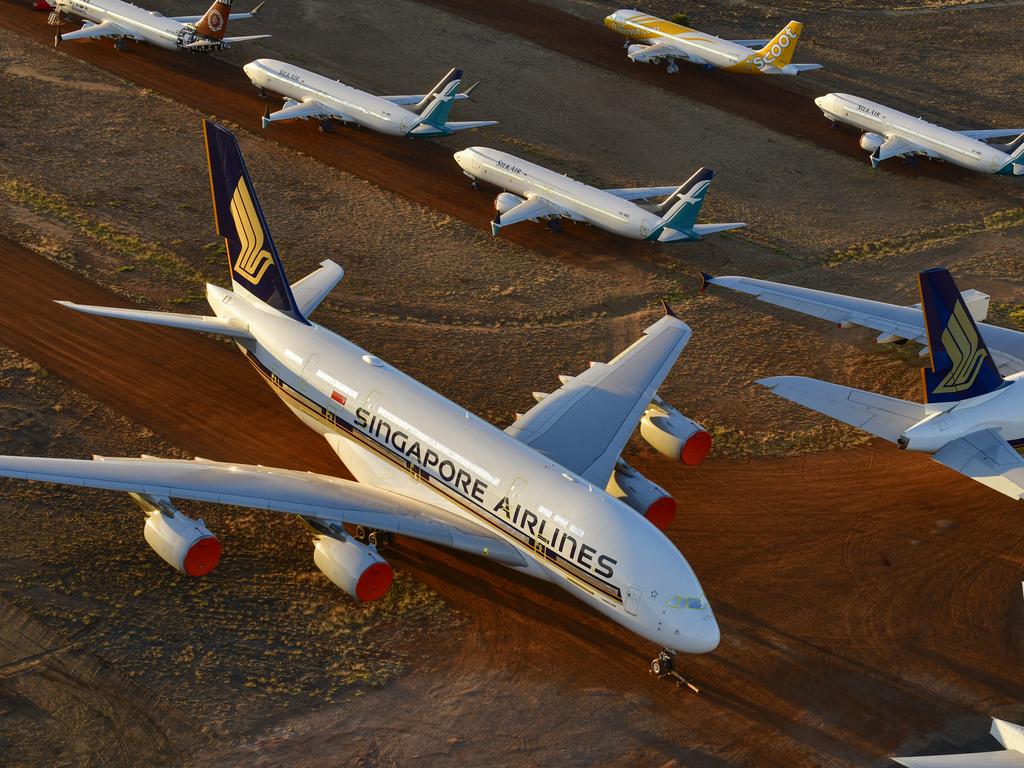Boeing 747: Queen of the flying kangaroo fleet flies into the sunset with a fine farewell from Qantas fans
For 49 of Qantas’s 100 years, the Boeing 747 Jumbo jet has been synonymous with the image of the flying kangaroo.
On Wednesday, a socially distanced crowd of 150 people gathered in the cavernous space of Qantas hanger 96 at Sydney Airport, to witness the abdication of the last queen of the skies.
For 49 of Qantas’s 100 years the Boeing 747 Jumbo jet has been synonymous with the image of the flying kangaroo, becoming the plane on which many Australians experienced their first international flight and a welcome sign at airports for travel-weary Australians returning home from the far-flung corners of the world.
The first delivery of the 747 – the a-200 series – was taken in 1971 at a modern-day equivalent cost of $1.5bn, a record breaking and daring investment for Qantas at a time when supersonic passenger jets like the Concorde were thought to be the future of air travel.
And off it goes ... job done #747farewell https://t.co/CsH8EZTR4T pic.twitter.com/g2zPRQvsR0
— Lisa Millar (@LisaMillar) July 22, 2020
The jet soon proved the doubters wrong, with its fuel economy and large passenger size making air travel economical for the average Australian while setting numerous world records, such as flying the first non-stop commercial flight from London to Sydney in 1989.
Such was the jet’s popularity that over the past 49 years, Qantas has operated a total of 65 747s – including a stint between 1979 and 1985 when the fleet was composed entirely of the jumbo.
But as aviation technology advanced, Qantas progressively upgraded its fleet with the final six 747s set to be retired at the end of the year – before the coronavirus pandemic brought forward their retirement to the depths of a plane graveyard in California’s Mojave Desert.
Speaking in front of the final 747 – part of the 400 series — Qantas CEO Alan Joyce paid tribute to the aircraft that “overcame the tyranny of distance” to open up the world to Australia.
“We’re here today to say farewell to the queen of the skies,” Mr Joyce said.
“We’re saying farewell to an aircraft that I think that has changed the world of aviation, an aircraft that has changed Qantas, an aircraft that has changed Australia.”
Mr Joyce said the 747 had played an integral part in the highs of Australia – ferrying hundreds of Olympic medals, sporting trophies, visiting dignitaries and even the Pope and the Queen into the country – but it was also witness to the lows, flying numerous rescue missions, most recently out of Wuhan.
“When Australians needed our help, this aircraft was the first aircraft, because of its reliability,” Mr Joyce said.
“It goes back as far as 1974 when the aircraft evacuated 674 Australians out of Darwin – still the record for the amount of people that were every flown on a 747.”
President of Boeing Australia and former Liberal leader Brendan Nelson told the crowd that the 747 “has meant more to me than perhaps you might ever understand”.
“It was this airline and Qantas flying the 747 that opened the prospect, the real and affordable prospect of travel to the rest of the world to the everyday Australian,” he said.
Backbone of the company
Those words rang true for 94-year-old Noel Taylor, the oldest living former Qantas employee, who started work for the firm cleaning spark plugs in 1942 before becoming a licensed engineer and taking his family around the world on 747 jaunts.
“That jumbo has always had a spirit about it,” Mr Taylor told The Australian. “I have great affection for it.”
Mr Taylor’s son Peter is also an engineer for Qantas, and the 747 was the first aircraft he was licensed to work on.
“It was just the backbone of the company,” he said. “It was the expansion of affordable travel for everyone. It allowed people to travel around the world for decades.”
As the take-off time of 2pm approached on Wednesday, the six pilots that were to fly the plane to the Mojave readied themselves for an emotional journey. For three of them, it would be their last for Qantas.
“Look, it’s a sad day. It’s a sad day for Qantas, it’s a sad day for anyone who has ever had any association with the jumbo,” retiring Captain Greg Fitzgerald told The Australian.
“I’ve been with Qantas for 34 years and I've been on a jumbo for 20 of those years.
“When they call it the queen of the skies, it’s for good reason. From a pilot’s point of view, it’s probably the nicest aeroplane that pilots have flown.
“I really don’t think there will ever be another aircraft ever that is as iconic as this one.”
At 2pm the 747 began backing out of the hanger for its final time to applause and an overture of “I Still Call Australia Home.”
Taking off over Botany Bay as flight QF7474, the plane pivoted north through especially clear airspace to fly over the CBD and the beaches of the northern and eastern suburbs – a final farewell to the city that was home for 17 years.
Turning around, the last reigning queen of the skies flew low over the HARS Aviation Museum at Albion Park and dipped its wings in tribute to the founder of the dynastic line: Qantas’s first 747-400, the VH-OJA, which is preserved there.
Then, over the Pacific Ocean, the six pilots manoeuvred the plane to draw a shape visible only to aviation enthusiasts watching over a flight tracker: The Qantas Kangaroo.







To join the conversation, please log in. Don't have an account? Register
Join the conversation, you are commenting as Logout